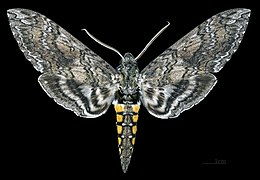Tobacco enthusiasts
| Tobacco enthusiasts | ||||||||||||
|---|---|---|---|---|---|---|---|---|---|---|---|---|

Tobacco Hawk ( Manduca sexta ) ♂ |
||||||||||||
| Systematics | ||||||||||||
|
||||||||||||
| Scientific name | ||||||||||||
| Manduca sexta | ||||||||||||
| ( Linnaeus , 1763) |
The tobacco hawk ( Manduca sexta ) is a butterfly ( moth ) from the family of the hawkmoth (Sphingidae).
features
The moths have brown patterned forewings; on their hind wings there are alternating light and brown bands that flow into each other. The abdomen is brown, the sides of each segment are yellow and dark towards the front. The males have significantly wider antennae than the females. The spherical eggs, about 1 millimeter in diameter, are transparent-green. The caterpillars are about 70 millimeters long. They are colored green and have seven bright stripes on the sides, similar to the caterpillars of the skull hawk ( Acherontia atropos ).
Similar species
Occurrence
The moths occur in large parts of North and South America .
Way of life
The nocturnal moths suck nectar from flowers and like all swarmers can fly on the spot. They have a life expectancy of 30 to 50 days.
Ingestion
The caterpillars feed on the nightshade family (Solanaceae), especially tobacco plants ( Nicotiana spec.). They tolerate the nicotine it contains and can accumulate it in the body, which makes them inedible for predators (“ pharmacophagy ”). They also feed on thorn apple ( Datura wrightii ), tomato ( Solanum lycopersicum , Solanaceae), Capsicum annuum and Proboscidea parviflora (Martyniaceae). The plants not only serve as the basis of life for the caterpillars, the adult swarmers also feed on their nectar. The adults can also develop other plants as a source of food through olfactory learning. Agave palmerii should be mentioned here especially among the swarmers occurring in Arizona . This agave, which is actually adapted to bats, is used by swarmers as a food source when D. wrightii is not yet sufficiently available.
Mating and development
The females mate only once, the males can mate several times. Mating takes place on the ground at night and can last for several hours. The female then usually lays her eggs on the underside of the leaves of the forage plants. The caterpillars hatch two to four days after laying. After five caterpillar stages, they pupate in the ground. Ideally, the pupal phase lasts around 18 days with 17 hours of daylight; if the daylight lasts less than 12 hours, the pupae can go into a diapause lasting several months .
Natural enemies
There are a number of brackish wasps living parasitically , such as B. those of the genus Cotesia , whose larvae develop in the caterpillars of the swarmers. Numerous brackish wasp larvae can attack a caterpillar at the same time. After the wasp larvae pupate, the dead caterpillar is covered with their white cocoons .
useful information
In neurobiology, the butterflies and caterpillars are model organisms for research into the nervous system , as they are easy to breed and the internal organs are easy to prepare due to their size.
At the Max Planck Institute for Chemical Ecology , researchers have discovered an astonishing strategy for tobacco plants in connection with Manduca sexta : While the wild tobacco plants normally defend themselves against predators by boosting nicotine production, they react when attacked by the tobacco hawk caterpillar not so. Obviously, these plants recognize the butterfly caterpillar by its saliva and do not try to drive it away, which ultimately benefits both the plant through pollination by the adult butterfly and the butterfly itself and its offspring.
Web links
- University of Florida Department of Entomology and Nematology (English)
- Sphingidae of the Americas (English)







